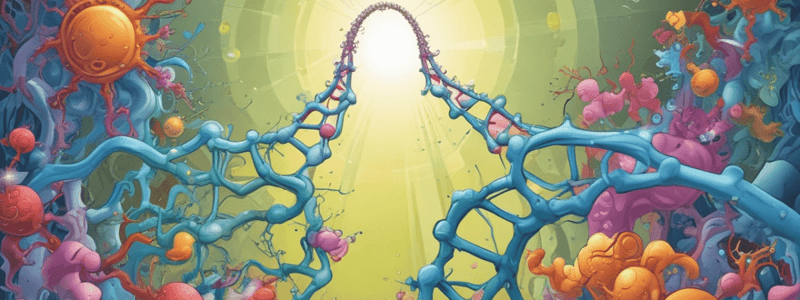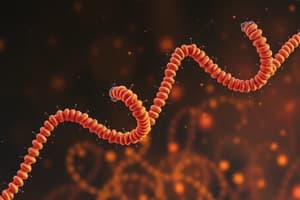Podcast
Questions and Answers
What is the function of aminoacyl-tRNA synthetases?
What is the function of aminoacyl-tRNA synthetases?
- To recognize codons on mRNA
- To synthesize tRNA molecules
- To catalyze the reaction of esterifying amino acids to tRNA molecules (correct)
- To translate mRNA into proteins
A specific aminoacyl-tRNA molecule can only recognize one codon on mRNA.
A specific aminoacyl-tRNA molecule can only recognize one codon on mRNA.
False (B)
What is the name of the complex that binds to formylmethionine-tRNAfmet during initiation?
What is the name of the complex that binds to formylmethionine-tRNAfmet during initiation?
[IF-2–GTP] complex
The ______________ phase of translation requires mRNA to be translated, 30S and 50S ribosome subunits, aminoacyl-tRNA molecules, and accessory proteins.
The ______________ phase of translation requires mRNA to be translated, 30S and 50S ribosome subunits, aminoacyl-tRNA molecules, and accessory proteins.
Match the following components with their roles in translation:
Match the following components with their roles in translation:
What is the result of an amino acid being esterified to the incorrect tRNA molecule?
What is the result of an amino acid being esterified to the incorrect tRNA molecule?
The Shine-Dalgarno sequence is involved in translation initiation.
The Shine-Dalgarno sequence is involved in translation initiation.
What is the overall reaction for amino acid activation?
What is the overall reaction for amino acid activation?
What is the function of the amino acid arm in tRNA?
What is the function of the amino acid arm in tRNA?
The genetic code is ambiguous, meaning that one codon can specify multiple amino acids.
The genetic code is ambiguous, meaning that one codon can specify multiple amino acids.
What is the term used to describe the phenomenon where multiple codons specify the same amino acid?
What is the term used to describe the phenomenon where multiple codons specify the same amino acid?
The secondary structure of tRNA resembles a _______________________
The secondary structure of tRNA resembles a _______________________
Match the following tRNA regions with their functions:
Match the following tRNA regions with their functions:
How many different codons specify the amino acid leucine?
How many different codons specify the amino acid leucine?
The genetic code is composed of 64 codons that specify the 20 standard amino acids.
The genetic code is composed of 64 codons that specify the 20 standard amino acids.
What is the function of termination codons in protein synthesis?
What is the function of termination codons in protein synthesis?
What percentage of total cellular RNA does mRNA account for in E. coli?
What percentage of total cellular RNA does mRNA account for in E. coli?
The genetic code is overlapping.
The genetic code is overlapping.
What is the function of tRNA during protein synthesis?
What is the function of tRNA during protein synthesis?
RRNA, together with several _______________, constitute the ribosome.
RRNA, together with several _______________, constitute the ribosome.
Match the type of RNA with its function:
Match the type of RNA with its function:
What is the function of the codon AUG in the genetic code?
What is the function of the codon AUG in the genetic code?
In prokaryotes, all AUG codons encode a modified methionine residue called formyl-methionine.
In prokaryotes, all AUG codons encode a modified methionine residue called formyl-methionine.
Why is mRNA generally more unstable than tRNA and rRNA?
Why is mRNA generally more unstable than tRNA and rRNA?
What is the sugar unit present in RNA?
What is the sugar unit present in RNA?
The nitrogenous base Thymine is found in RNA instead of Uracil in DNA.
The nitrogenous base Thymine is found in RNA instead of Uracil in DNA.
What is the type of bond that connects the nucleotides in RNA?
What is the type of bond that connects the nucleotides in RNA?
The number of nucleotides in RNA can range from as few as _______ to many thousands.
The number of nucleotides in RNA can range from as few as _______ to many thousands.
Match the following nitrogenous bases with their correct pairing partners:
Match the following nitrogenous bases with their correct pairing partners:
What is the primary difference between the sugar unit in RNA and DNA?
What is the primary difference between the sugar unit in RNA and DNA?
The molecular structure of RNA is identical to DNA.
The molecular structure of RNA is identical to DNA.
What is the name of the type of bond that connects the ribonucleotide residues in a RNA strand?
What is the name of the type of bond that connects the ribonucleotide residues in a RNA strand?
What is the role of IF-2 in the initiation of prokaryotic translation?
What is the role of IF-2 in the initiation of prokaryotic translation?
The 30S subunit binds to mRNA in a non-specific manner.
The 30S subunit binds to mRNA in a non-specific manner.
What is the purpose of translational regulation?
What is the purpose of translational regulation?
The Shine-Dalgarno sequence is located near the ______________ end of mRNA.
The Shine-Dalgarno sequence is located near the ______________ end of mRNA.
During which phases of protein synthesis can translational regulation occur?
During which phases of protein synthesis can translational regulation occur?
In prokaryotes, the synthesis of ribosomal proteins is uncoupled from the rate of ribosome assembly.
In prokaryotes, the synthesis of ribosomal proteins is uncoupled from the rate of ribosome assembly.
The ______________ site is where the AUG initiation codon is positioned in the 30S subunit.
The ______________ site is where the AUG initiation codon is positioned in the 30S subunit.
Match the following components with their roles in prokaryotic translation initiation:
Match the following components with their roles in prokaryotic translation initiation:
Flashcards are hidden until you start studying
Study Notes
Structure of RNA
- RNA is a long, unbranched macromolecule consisting of nucleotides joined by 3'-5' phosphodiester bonds.
- The number of nucleotides in RNA ranges from as few as 75 to many thousands.
- RNA differs from DNA in two ways:
- The sugar unit in RNA is D-Ribose, which contains a 2'-hydroxyl group not present in deoxyribose.
- Uracil is found in RNA instead of thymine, which is present in DNA.
Types of RNA
- There are several types of RNA, including:
- tRNA (transfer RNA): interprets the genetic code and is the crucial link between the genetic code in mRNA and the sequence of amino acids in a protein.
- rRNA (ribosomal RNA): constitutes the ribosome, together with several proteins, and is involved in protein synthesis.
- mRNA (messenger RNA): specifies the amino acid sequence during protein synthesis.
- Small RNA molecules: have catalytic activity and are involved in processing the above RNA molecules.
tRNA Structure and Function
- tRNA molecules are approximately 73-93 nucleotides long.
- The secondary structure of tRNA resembles a clover-leaf, with stem and loop formations due to self-complementary intrachain base pairing.
- tRNA contains unusual bases, such as dihydrouridine and pseudouridine.
- The amino acid arm (at the 3' end) serves as the point for amino acid attachment and subsequent transport to the ribosome.
- The anticodon loop contains the anticodon, which forms a complementary base pair interaction with the codon in mRNA.
Translation in Prokaryotes
- The translation process contains three distinct phases: initiation, elongation, and termination.
- Initiation requires:
- mRNA to be translated
- 30S and 50S ribosome subunits
- Aminoacyl-tRNA molecules
- Accessory proteins (initiation, elongation, and release/termination factors)
- Initiation factors 1 and 3 bind to the 30S ribosome subunit, with IF-3 preventing premature association with the 50S subunit.
Aminoacyl-tRNA Synthetases
- A specific amino acid is esterified to the 3' end of a correct tRNA molecule, forming an aminoacyl-tRNA molecule.
- Aminoacyl-tRNA is a high-energy molecule, with the attached amino acid "activated" for incorporation into a polypeptide.
- Aminoacyl-tRNA synthetases have an error-checking function and rapidly correct errors.
Genetic Code
- The genetic code refers to the triplet base sequences in mRNA (or DNA) that specify the amino acids to be incorporated into a protein.
- The genetic code contains all the information for initiating translation, specifying amino acid sequence, terminating translation, and releasing the nascent protein.
- The genetic code is non-overlapping and made up of 64 codons.
Regulation of Translation
- Translational regulation is essential in controlling gene expression and provides a means of controlling cellular protein levels.
- Regulation of translation can be achieved during the initiation, elongation, or termination phases of protein synthesis.
Studying That Suits You
Use AI to generate personalized quizzes and flashcards to suit your learning preferences.


